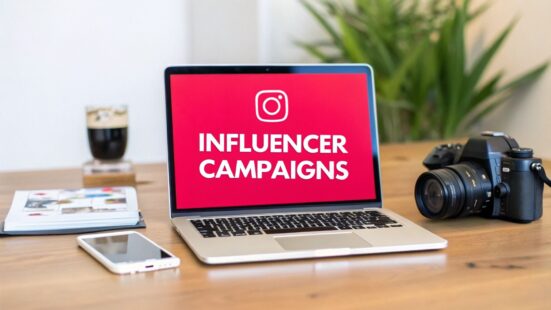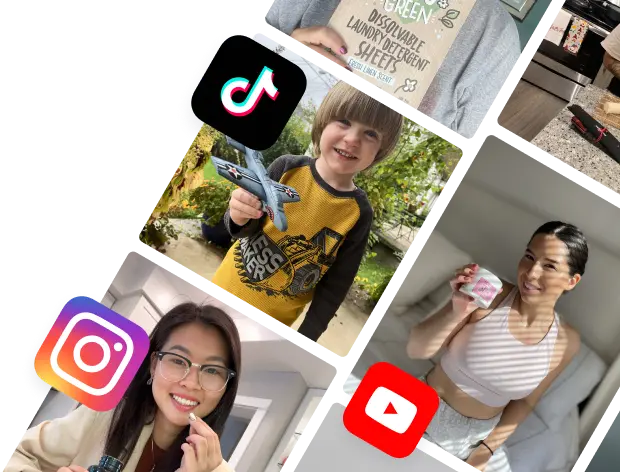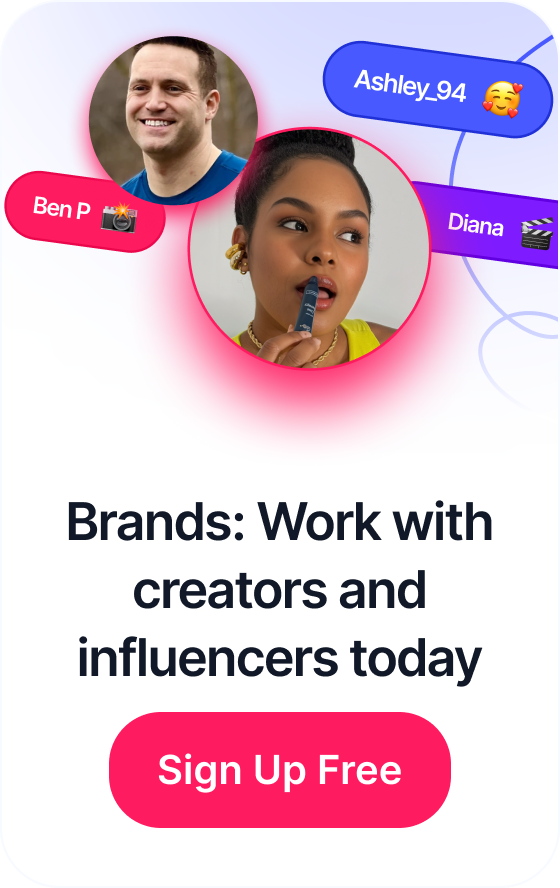 How to Find Influencer Amazon Storefront – Full Guide, Tips, FAQs & More
How to Find Influencer Amazon Storefront – Full Guide, Tips, FAQs & More
Table of Contents
Unleashing the Power of Influencers
Want to see influencer marketing in action? This listicle provides seven influencer marketing campaign examples to inspire your own strategy. Learn how brands like Nike, Glossier, and Dunkin’ Donuts successfully leveraged influencer collaborations to drive sales, boost brand awareness, and build customer loyalty. Discover how these campaigns used different platforms and influencer types, from mega-influencers to micro-influencers, and find actionable tactics you can use for your next influencer marketing campaign. We’ll cover examples from TikTok and Instagram to broad-reach partnerships, providing diverse strategies for all brand sizes.
1. Nike’s #JustDoIt Campaign with Colin Kaepernick
This influencer marketing campaign stands as a prime example of how brands can leverage social activism to generate significant brand awareness and engage with their target audience on a deeper level. In 2018, Nike partnered with former NFL quarterback Colin Kaepernick, a controversial figure known for kneeling during the national anthem to protest racial injustice. The campaign, built around the tagline “Believe in something. Even if it means sacrificing everything,” directly addressed Kaepernick’s actions and sparked a national conversation about social responsibility and brand activism. This bold move demonstrated how a brand could align itself with a social cause, using an influencer as the mouthpiece, and generate immense buzz. The campaign wasn’t just a single advertisement; it was a multi-platform strategy encompassing television commercials, social media engagement, and billboard placements, demonstrating the power of integrated marketing.

This campaign is a powerful influencer marketing example due to its authentic approach, clear messaging, and multi-platform execution. It effectively utilized Kaepernick’s existing platform and amplified his message, resonating deeply with Nike’s target demographic. The campaign proved that taking a calculated risk on a controversial figure can yield substantial returns, even amidst potential backlash.
This infographic visualizes key statistics demonstrating the impact of the #JustDoIt campaign.

The infographic showcases the significant positive impact of the campaign: a $6 billion increase in brand value and a 5% surge in Nike’s stock value, highlighting how taking a stand can be financially beneficial. The 80 million views on the ‘Dream Crazy’ commercial and the trending campaign hashtag underscore the massive reach and engagement generated by the campaign.
Features: Celebrity athlete partnership, Social justice messaging, Controversial yet authentic approach, Cross-platform implementation (TV, social media, billboards)
Pros: Generated $6 billion in brand value, Increased Nike’s stock value by 5%, Created massive social media engagement, Strengthened brand loyalty among core demographic.
Cons: Faced backlash from conservative consumers, Some consumers boycotted the brand, Potentially alienated certain market segments, Risk of being perceived as exploiting social issues.
Examples: The 30th anniversary ‘Dream Crazy’ commercial featuring Kaepernick reached over 80 million views, the campaign hashtag trended globally for several days, and the campaign sparked nationwide conversation about brands taking political stances.
Tips for Implementing Similar Campaigns:
- Ensure Alignment: Ensure the influencer’s values align with your brand identity for an authentic partnership.
- Be Prepared for Backlash: Addressing controversial topics requires anticipating and managing potential negative reactions.
- Multi-Channel Strategy: Utilize a multi-channel content strategy to maximize reach and impact.
- Authentic Storytelling: Prioritize authentic storytelling over direct product promotion to resonate with your audience.
When and Why to Use This Approach: This approach is ideal when your brand aims to connect with its target audience on a deeper level by aligning with a social cause. It’s particularly effective when your target demographic is passionate about specific issues. However, it’s crucial to thoroughly assess the potential risks and ensure your brand is prepared to navigate potential controversy.
Popularized By: Colin Kaepernick (former NFL quarterback), Nike, Wieden+Kennedy (advertising agency).
This campaign deserves its place on this list of influencer marketing campaign examples because it demonstrates the power of taking a stand and using an influencer to amplify a message. It showcases how a calculated risk, coupled with authentic storytelling and strategic execution, can create significant brand awareness and drive substantial business results. It serves as a case study for brands considering aligning with social causes and engaging in influencer marketing that goes beyond simple product endorsements.
2. Daniel Wellington’s Instagram Micro-Influencer Strategy
This influencer marketing campaign example showcases the power of leveraging micro-influencers on Instagram. Daniel Wellington, a watch brand, provides a compelling case study for how this strategy can propel a brand to rapid growth. Instead of relying on expensive celebrity endorsements, Daniel Wellington tapped into the authentic influence of thousands of micro-influencers (individuals with 1,000-100,000 followers) within the fashion and lifestyle niche. This approach deserves its place on this list because it demonstrates a highly effective, and potentially replicable, method for achieving significant brand awareness and sales growth through influencer marketing.
How It Works:
Daniel Wellington provided micro-influencers with free watches and unique discount codes. The influencers then integrated the watches into their Instagram content, creating organic-looking posts featuring the product. This strategy generated a ripple effect across the platform, exposing the brand to a vast and diverse audience. The affiliate code system allowed Daniel Wellington to track conversions and directly attribute sales to individual influencers, providing valuable data for campaign optimization. This approach proved highly effective due to several key features: a micro-influencer focused approach, maintaining a consistent aesthetic across all posts, an affiliate code system for tracking conversions, and minimal product cost (watches) for maximum exposure.
Examples of Success:
- Massive Instagram Growth: Daniel Wellington’s Instagram following grew to over 4.9 million.
- User-Generated Content Explosion: The campaign generated over 1 million posts with the #DanielWellington hashtag.
- Retail Expansion: The brand expanded from an online-only business to over 4,000 retail locations worldwide, fuelled by the online awareness created by the campaign.
Pros:
- Higher Engagement Rates: Micro-influencers generally have higher engagement rates than celebrity influencers due to a stronger sense of community with their followers.
- Authentic Recommendations: Content created by micro-influencers feels more authentic and relatable to their audience, leading to greater trust and higher conversion rates.
- Lower Cost: Collaborating with micro-influencers is significantly less expensive than partnering with celebrities, making it a more accessible strategy for many brands.
- Greater Reach: Working with numerous micro-influencers allows brands to reach a broader and more diverse audience than focusing on a few large accounts.
Cons:
- Management Complexity: Managing thousands of influencer relationships can be logistically challenging.
- Content Quality Control: Maintaining consistent brand messaging and content quality across a large number of influencers requires careful planning and monitoring.
- Market Saturation: Overexposure within a specific niche can lead to market saturation and decreased effectiveness.
- ROI Measurement: While affiliate codes provide some data, accurately measuring the overall ROI of a large-scale micro-influencer campaign can be complex.
Tips for Implementation:
- Consistent Aesthetics: Establish clear brand guidelines and ensure consistent aesthetics across all influencer content.
- Unique Discount Codes: Provide each influencer with a unique discount code to track performance and attribute conversions.
- Prioritize Engagement: Focus on engagement rates over follower count when selecting micro-influencers.
- Creative Freedom: Offer clear content guidelines while allowing influencers creative freedom to ensure authenticity.
When to Use This Approach:
This strategy is particularly effective for DTC and e-commerce brands, startups, and companies launching new products aiming to build brand awareness quickly and cost-effectively. It is ideal for reaching niche audiences and driving online sales. This approach is also valuable for software and app developers, SaaS founders, and CPG founders looking to generate buzz and acquire new users.
Popularized By: Filip Tysander (Daniel Wellington founder), and thousands of Instagram fashion micro-influencers.
This example offers a blueprint for how leveraging micro-influencers on Instagram can create a powerful and cost-effective influencer marketing campaign. By following the tips provided and carefully managing influencer relationships, brands can achieve similar success and effectively reach their target audience.
3. Glossier’s Customer-as-Influencer Approach
Glossier’s approach to influencer marketing redefines the concept entirely. Instead of relying on celebrity endorsements or macro-influencers, the beauty brand strategically leverages its own customer base as its primary marketing force. This customer-as-influencer model prioritizes authenticity and community building, transforming everyday users into passionate brand advocates who generate user-generated content (UGC). This strategy has been instrumental in Glossier’s growth from a startup to a billion-dollar company, proving the power of organic reach and genuine word-of-mouth marketing. This approach is a prime influencer marketing campaign example because it demonstrates how building a strong community can effectively replace or significantly supplement more traditional, expensive influencer campaigns.
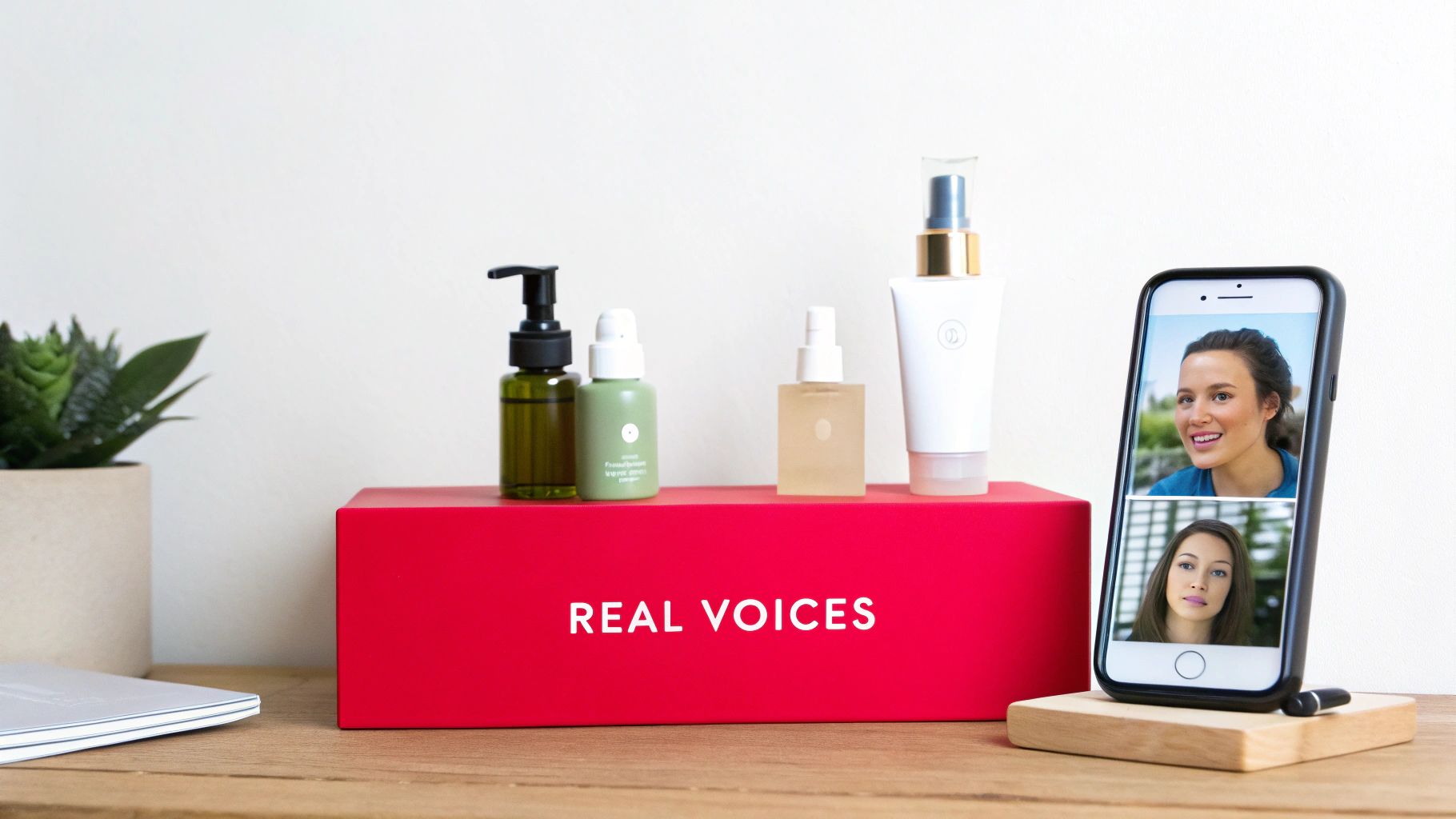
Glossier’s success hinges on several key features: using UGC as primary marketing material, representative casting featuring real customers in their marketing, a strong emphasis on community building, and product development informed by direct customer feedback. This creates a feedback loop where customers feel valued and heard, further strengthening their connection to the brand. Campaigns like the #ShelfieShowcase, featuring real customers’ bathroom shelves showcasing Glossier products, and the regular inclusion of diverse customers in official marketing materials exemplify this strategy. The foundation of this approach began with Into The Gloss, a beauty blog founded by Emily Weiss (Glossier’s founder), which fostered a strong community and provided valuable insights into consumer preferences. This existing community became the launchpad for Glossier, demonstrating the power of a pre-built engaged audience.
Pros:
- Exceptionally high authenticity perception: Content created by real users feels genuine and relatable, fostering trust among potential customers.
- Lower marketing costs: Compared to traditional influencer collaborations, leveraging existing customers significantly reduces marketing spend.
- Strong customer loyalty and retention: Customers feel valued and invested in the brand, leading to increased loyalty and repeat purchases.
- Continuous stream of fresh content: An active customer base provides a consistent flow of new content, reducing the need for constant in-house content creation.
Cons:
- Less control over brand messaging: While brands can encourage certain types of content, they ultimately have less control over the specific narratives generated by users.
- Requires excellent product experience to generate positive UGC: A subpar product is unlikely to generate positive organic buzz, making product quality crucial.
- Challenging to scale while maintaining authenticity: As a brand grows, maintaining the close-knit community feel can become difficult.
- Results may take longer than traditional campaigns: Building a thriving community and generating substantial UGC requires time and consistent effort.
Tips for Implementing a Customer-as-Influencer Approach:
- Create shareable packaging and unboxing experiences: Encourage customers to document their product journey from the moment they receive it.
- Engage directly with customers who create content: Show appreciation by reposting, commenting, and highlighting user-generated content.
- Build platforms for community interaction: Facilitate conversations and connections between customers through dedicated online spaces.
- Feature diverse real customers rather than only aspirational influencers: Representativeness fosters inclusivity and strengthens community bonds.
When and Why to Use This Approach:
This strategy is particularly effective for DTC and e-commerce brands, startups, and companies with strong community-focused values. It’s ideal for brands looking to build long-term relationships with customers, foster authenticity, and generate organic growth. This customer-centric approach is especially valuable for brands with limited marketing budgets, as it leverages the power of word-of-mouth marketing and reduces reliance on paid advertising. Glossier’s success serves as a compelling influencer marketing campaign example for brands seeking to build a loyal customer base and drive organic growth through genuine engagement.
4. Dunkin’ Donuts and Charli D’Amelio TikTok Partnership
This influencer marketing campaign stands as a prime example of how brands can effectively leverage the power of TikTok and Gen Z influencers to drive significant results. It’s a strong influencer marketing campaign example because it demonstrates the potential of aligning with an authentic fan base on an emerging platform. The partnership between Dunkin’ Donuts and Charli D’Amelio, a TikTok superstar with over 100 million followers at the time, centered around the creation of “The Charli” – a custom coffee drink based on D’Amelio’s go-to Dunkin’ order. This campaign’s success makes it a valuable case study for anyone exploring influencer marketing, particularly within the DTC and e-commerce space.
How it Works:
The campaign capitalized on D’Amelio’s pre-existing and genuine love for Dunkin’, which she frequently expressed on her TikTok channel before any formal partnership. This authenticity resonated deeply with her followers. Dunkin’ cleverly integrated D’Amelio’s personality and signature dance moves into a multi-pronged campaign that spanned TikTok, other social media platforms, and even in-store promotions.
Examples of Implementation:
- “The Charli” Signature Drink: This custom-named beverage provided a tangible product directly linked to the influencer, allowing fans to participate in the trend and experience something D’Amelio enjoyed.
- “Charli x Dunkin'” Merchandise Collection: Expanding beyond just the drink, the partnership included branded merchandise, further cementing the collaboration in the minds of consumers and providing additional revenue streams.
- TikTok Challenge: A branded TikTok challenge encouraged users to recreate D’Amelio’s dance moves while enjoying “The Charli,” amplifying the campaign’s reach organically through user-generated content.
Features and Benefits:
- Custom product named after influencer: Created a sense of exclusivity and connection.
- Platform-specific content strategy for TikTok: The campaign effectively utilized TikTok’s unique features and trends.
- Leveraged pre-existing authentic relationship: This ensured the partnership felt genuine and resonated with D’Amelio’s audience.
- Cross-promotion across physical stores and digital channels: This maximized reach and impact.
Pros:
- Increased App Downloads: Dunkin’ saw a 57% surge in app downloads, demonstrating the campaign’s effectiveness in driving digital engagement.
- Boosted Sales: Cold brew sales (the base of “The Charli”) saw a 45% increase, directly linking the campaign to tangible business outcomes.
- Massive Impressions: The campaign generated over 294 million TikTok impressions, showcasing its impressive reach and visibility.
- Engagement with Younger Demographic: The partnership successfully engaged a younger audience, crucial for long-term brand growth.
Cons:
- Limited Long-Term Brand Building: The campaign’s impact primarily focused on the short-term promotion.
- Reliance on a Single Influencer: This created a dependency on D’Amelio’s continued popularity and risked negative impact from potential controversies.
- Potential Overexposure to Narrow Demographic: Focusing solely on D’Amelio’s Gen Z fanbase could alienate other demographics.
- Risk of Influencer Controversy: Any negative publicity surrounding D’Amelio could negatively affect Dunkin’s brand image.
Tips for Implementing Similar Campaigns:
- Authenticity is Key: Ensure the influencer has a genuine connection to your brand before entering a partnership.
- Tangible Engagement: Create tangible products or experiences that fans can actively participate in.
- Platform Optimization: Adapt your content style to match the platform’s norms and best practices.
- Measure Impact: Track both social engagement metrics (impressions, likes, shares) and actual sales impact to assess the campaign’s effectiveness.
When and Why to Use This Approach:
This approach is particularly effective for DTC and e-commerce brands targeting a younger demographic, especially Gen Z and Millennials. It works best when launching a new product, refreshing an existing offering, or driving app downloads and digital engagement. However, it’s crucial to consider the potential risks associated with relying heavily on a single influencer and to have a strategy in place to mitigate those risks. This campaign serves as a valuable influencer marketing campaign example for brands looking to tap into the power of TikTok and celebrity endorsements.
5. Gymshark’s Fitness Influencer Collective: A Blueprint for Building a Brand Through Community
Gymshark’s meteoric rise from a small UK startup to a global fitness apparel empire offers a compelling influencer marketing campaign example. Their success story hinges on the creation of the “Gymshark Athletes” program, a carefully curated collective of fitness influencers, which exemplifies the power of community-driven marketing. This approach moves beyond transactional sponsorships and prioritizes building long-term partnerships that foster authentic brand advocacy. This makes it a valuable case study for DTC and E-commerce brands, digital marketing agencies, and anyone working with influencers.
This method essentially involves identifying and partnering with key influencers who genuinely align with your brand values and target audience. Instead of one-off posts, Gymshark cultivates ongoing relationships with its athletes, providing them with free products, exclusive deals, and collaborative opportunities. These influencers, in turn, become integrated into the brand’s identity, creating content that resonates with their followers and acting as genuine ambassadors.
How it works:
Gymshark cultivates a sense of belonging among its athletes, fostering a close-knit community. This approach goes beyond simply sending free merchandise; it’s about creating shared experiences. The brand organizes events, like the massively popular Gymshark Central Birmingham pop-up store, which saw lines around the block, to connect influencers with their followers and reinforce the community aspect. This blend of online and offline engagement is crucial for building deep, lasting connections.
Examples of successful implementation:
- Gymshark Central Birmingham pop-up: This event showcased the power of combining digital influence with a physical experience, generating immense buzz and strengthening the community bond.
- Gymshark Athletes YouTube fitness series: By creating exclusive content featuring their athletes, Gymshark provides value to their audience while simultaneously promoting their products organically.
- Coordinated product launches with influencer content: Gymshark strategically aligns product launches with influencer posts, maximizing reach and impact.
Tips for leveraging this approach:
- Invest in genuine relationships: Don’t just treat influencers as billboards. Get to know them, understand their values, and build authentic connections.
- Create exclusive content or products: Offer your influencers something unique that they can share with their audience, fostering a sense of exclusivity and value.
- Combine digital influence with physical events: Bridge the gap between online and offline interaction through meet-ups, pop-up shops, or sponsored events.
- Select influencers who embody brand values beyond follower count: Prioritize authenticity and shared values over sheer numbers. A smaller, highly engaged audience can often be more valuable than a massive, passive one.
Pros:
- Built authentic credibility in the fitness community: The Gymshark Athletes are seen as credible figures within their niche, lending authenticity to the brand.
- Created consistent brand representation across social platforms: The collective ensures a unified brand voice and aesthetic across various social media channels.
- Generated loyalty among both influencers and consumers: The community-focused approach fosters loyalty from both the influencers within the collective and the consumers who admire them.
- Expanded globally through region-specific influencers: Gymshark strategically uses influencers in different regions to tap into new markets and expand its global reach.
Cons:
- Significant investment in relationship management: Building and maintaining genuine relationships with influencers requires dedicated time and resources.
- Risk of influencers moving to competitor brands: There’s always a risk of losing influencers to competitors, especially in a competitive landscape.
- Challenge of maintaining authenticity at scale: As the brand grows, maintaining the initial sense of authenticity can become increasingly difficult.
- Potential market saturation in the fitness influencer space: The fitness influencer market is becoming increasingly crowded, which can make it challenging to stand out.
Why Gymshark deserves its place on this list:
Gymshark’s influencer marketing campaign stands as a testament to the power of building a brand through community. By prioritizing authentic relationships and shared values, Gymshark has created a loyal following of both influencers and consumers. This strategy provides a valuable blueprint for businesses looking to leverage the power of influencer marketing to build a strong brand identity and drive significant growth. This example is particularly relevant for DTC and E-commerce brands, digital marketing and advertising agencies, in-house social media managers, and startups, offering a scalable and replicable model for success. While there are inherent challenges, the potential rewards of this approach, when executed correctly, are undeniable.
6. Airbnb’s National Geographic Partnership
Airbnb’s partnership with National Geographic, dubbed the “Night At” campaign, stands as a prime example of a high-impact influencer marketing campaign. Launched in 2015, this collaboration moved beyond traditional product promotion, focusing instead on crafting unique, shareable experiences. By partnering with National Geographic’s esteemed photographers, Airbnb offered exclusive overnight stays in extraordinary locations around the globe. These influencers documented their experiences, creating compelling visual content that showcased the platform’s ability to connect travelers with unforgettable adventures. This approach highlighted the core value proposition of Airbnb: not just accommodation, but access to unique travel experiences.
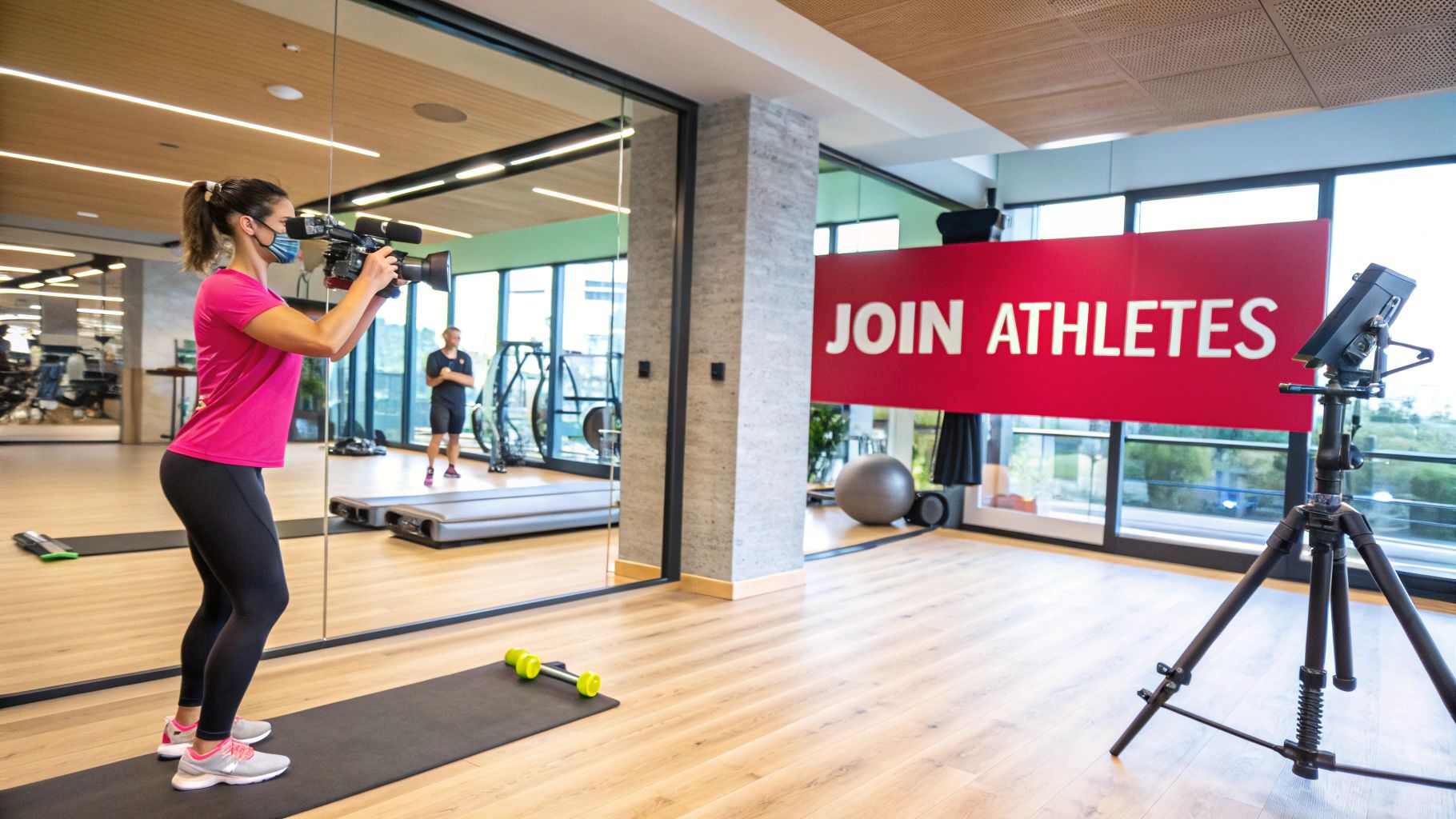
This influencer marketing campaign example demonstrates the power of aligning with a brand that shares a similar audience and values. Leveraging National Geographic’s established credibility and reach within the travel community allowed Airbnb to access a highly engaged target audience. The content-driven approach, emphasizing high-quality photography and storytelling, resonated deeply with travelers seeking authentic and inspiring experiences. Examples of these remarkable stays included an overnight stay in a converted KLM airplane, a shark aquarium sleepover in Paris, and a floating house on the Thames River in London.
This campaign deserves its place on this list because it exemplifies a sophisticated approach to influencer marketing. It wasn’t just about getting a celebrity to endorse a product; it was about creating truly remarkable experiences and leveraging the expertise of National Geographic’s photographers to document and share them. Key features included a partnership between two well-established brands, a content-focused strategy as opposed to direct advertising, the use of professional photographers as specialized influencers, and a strong emphasis on experience-based marketing.
Pros:
- High-quality visual content production: National Geographic photographers delivered stunning imagery and videos that captured the essence of each unique location.
- Leveraged credibility of National Geographic: The partnership instantly imbued the campaign with a sense of adventure, exploration, and authenticity.
- Created aspirational but achievable travel content: The experiences, while extraordinary, felt attainable, inspiring viewers to consider similar adventures through Airbnb.
- Differentiated Airbnb from traditional hospitality options: The campaign solidified Airbnb’s position as a facilitator of unique travel experiences, not just another booking platform.
Cons:
- Higher cost than typical influencer campaigns: Partnering with renowned photographers and securing access to unique locations came at a premium.
- Limited scale compared to micro-influencer strategies: This campaign focused on a smaller number of high-profile influencers, limiting its reach compared to campaigns leveraging a larger network of micro-influencers.
- Complex coordination between multiple stakeholders: Managing logistics for international shoots and coordinating with both Airbnb and National Geographic teams presented significant organizational challenges.
- Primarily reached higher-income travel market: The focus on luxury experiences and exotic locations tended to attract a more affluent segment of the travel market.
Tips for implementing similar strategies:
- Focus on creating remarkable experiences worth sharing: The experience itself is the foundation of a successful campaign.
- Partner with influencers who have specific expertise relevant to the campaign: National Geographic’s photographers were a perfect fit for a travel-focused campaign.
- Prioritize content quality over quantity: Fewer, high-quality pieces of content will have a greater impact than a large volume of mediocre content.
- Create interactive elements that engage the audience beyond watching: Encourage interaction through contests, Q&A sessions, or behind-the-scenes content.
This approach is particularly effective for brands seeking to establish themselves within a specific niche or elevate their brand image. By partnering with established authorities in their field, brands can leverage existing trust and credibility to reach a highly engaged audience. This campaign was popularized by the National Geographic photographers, the Airbnb marketing team, and the featured hosts with unique properties. While no specific website link exists solely for this campaign, searching for “Airbnb National Geographic Night At” will yield various articles and resources related to the partnership. This example provides valuable insights for DTC and e-commerce brands, marketing agencies, social media managers, startups, and established companies alike, showcasing the power of experience-driven influencer marketing.
7. Fenty Beauty’s Inclusive Influencer Campaign
This influencer marketing campaign example demonstrates the power of diversity and inclusion. When Rihanna launched Fenty Beauty in 2017, she disrupted the beauty industry with a campaign that prioritized representation over reach. This approach resonated deeply with consumers and set a new standard for influencer marketing, making it a must-study example for anyone looking to build a truly successful campaign.
What it is and how it works:
Fenty Beauty’s strategy moved away from the traditional influencer marketing model of partnering solely with mega-influencers. Instead, the brand collaborated with a diverse group of beauty influencers across a spectrum of skin tones, ethnicities, genders, and body types. This approach directly highlighted the brand’s expansive 40-shade foundation range (a groundbreaking offering at the time) and authentically communicated its commitment to inclusivity. By showcasing the product on a diverse range of individuals, Fenty Beauty generated genuine product reviews and built trust across a broader audience. This influencer marketing campaign example proved that representation fosters deeper connections with consumers.
Examples of Successful Implementation:
- Launch Campaign featuring 50+ Influencers: The initial launch campaign involved over 50 influencers of varying backgrounds, showcasing the foundation on a wide array of skin tones. This generated significant buzz and highlighted the brand’s dedication to inclusivity from day one.
- #ShadesThatMatch Campaign: This campaign focused on influencers finding their perfect foundation match within the 40-shade range, further emphasizing the brand’s commitment to catering to everyone.
- Tutorials for Different Skin Types and Concerns: Influencers created makeup tutorials tailored to specific skin types and concerns, offering practical advice and demonstrating the product’s versatility. This provided valuable content for consumers and strengthened the brand’s position as a beauty authority.
Tips for Implementing This Approach:
- Ensure Product Development Supports Marketing Claims: Authenticity is key. Your product must genuinely deliver on the promise of inclusivity.
- Select Influencers Who Represent Your Target Audiences Authentically: Partner with influencers who genuinely align with your brand values and resonate with your target demographics. Avoid tokenism.
- Create Campaign Briefs That Allow for Personalization: Give influencers the freedom to showcase the product in a way that feels authentic to their personal style and audience.
- Measure Both Engagement Metrics and Sentiment Analysis: Track traditional engagement metrics like likes and comments, but also analyze the sentiment expressed in audience interactions to understand the true impact of your campaign.
Pros:
- Created Strong Emotional Connection with Underrepresented Consumers: By seeing themselves represented in the brand’s marketing, consumers from marginalized groups felt seen and valued.
- Generated Authentic Product Testing Across Skin Tones: This provided valuable social proof and demonstrated the product’s efficacy for a diverse range of consumers.
- Established Brand as Industry Leader in Inclusivity: Fenty Beauty set a new standard for inclusivity in the beauty industry, inspiring other brands to follow suit.
- Built Loyal Community Across Diverse Segments: The campaign fostered a sense of community among consumers who appreciated the brand’s commitment to representation.
Cons:
- Higher Complexity in Campaign Management: Managing a large and diverse group of influencers requires more coordination and resources.
- Challenging to Maintain Consistent Messaging Across Diverse Influencers: Balancing brand consistency with individual influencer authenticity can be difficult.
- Required Greater Product Range Development: Developing a truly inclusive product range requires significant investment in research and development.
- Higher Initial Production Costs for Inclusive Shade Range: Producing a wider range of shades can be more expensive than a limited offering.
When and Why to Use This Approach:
This approach is particularly effective for brands targeting diverse demographics or operating in industries where representation has historically been lacking. It’s ideal for building brand loyalty, establishing authenticity, and generating genuine product reviews. This influencer marketing campaign example works best when a brand genuinely commits to inclusivity throughout its operations, not just in its marketing.
Popularized By: Rihanna (founder), Diverse beauty influencers across platforms, Kendo Beauty (parent company)
(No Website link publicly available for the specific campaign)
This influencer marketing campaign example deserves a place on this list because it fundamentally shifted the landscape of influencer marketing. It demonstrated that inclusivity is not just a buzzword, but a powerful business strategy that can drive authentic engagement and build lasting brand loyalty. It serves as a blueprint for brands seeking to create meaningful connections with diverse audiences.
7 Influencer Marketing Campaigns Compared
| Campaign | Implementation Complexity 🔄 | Resource Requirements 💡 | Expected Outcomes 📊 | Ideal Use Cases 💡 | Key Advantages ⭐ |
|---|---|---|---|---|---|
| Nike’s #JustDoIt with Colin Kaepernick | High – cross-platform, controversial messaging | High – celebrity partnership, multi-channel | Very high – $6B brand value, 26% sales boost | Brands taking bold social or political stands | Strong brand loyalty, massive awareness |
| Daniel Wellington’s Instagram Micro-Influencer | Medium – managing thousands of influencers | Medium – product cost, influencer management | High – $220M growth, 4.9M Instagram followers | Products targeting diverse social segments | High engagement, low cost per influencer |
| Glossier’s Customer-as-Influencer Approach | Medium – community building and UGC management | Low to medium – relies on customer content | High – 70% sales via peer recommendations | Brands focusing on authentic customer advocacy | High authenticity, low marketing spend |
| Dunkin’ Donuts & Charli D’Amelio TikTok | Low to medium – platform-focused, single influencer | Medium – product creation, influencer fee | High short-term – 57% app download increase | Youth brands targeting Gen Z on emerging platforms | Fast engagement, strong Gen Z appeal |
| Gymshark’s Fitness Influencer Collective | High – long-term relationship building | High – product giveaways, events | Very high – billion-dollar valuation | Fitness/lifestyle brands building enduring influence | Authentic community, global expansion |
| Airbnb & National Geographic Partnership | High – complex collaboration, content-driven | High – professional content creation | Medium to high – aspirational brand positioning | Experience-focused marketing and brand differentiation | High-quality content, unique brand positioning |
| Fenty Beauty’s Inclusive Influencer Campaign | High – diverse influencer coordination | High – product range, campaign scale | Very high – $100M+ sales in 40 days | Inclusive brands targeting diverse demographics | Industry leadership in inclusivity, deep loyalty |
Elevate Your Brand with Strategic Influencer Partnerships
These influencer marketing campaign examples, from Nike’s bold social statement to Glossier’s organic community building and Dunkin’ Donuts’ savvy TikTok strategy, demonstrate the power and versatility of influencer marketing. The key takeaway is that success lies in strategic alignment: choosing influencers who genuinely resonate with your brand values and target audience, crafting authentic and engaging content, and selecting the right platforms to amplify your message. Whether you’re driving social change, launching a new product, or building a loyal customer base, mastering these principles can significantly impact your brand’s reach and resonance. If you’re looking to elevate your influencer marketing campaigns, consider partnering with a specialized agency. They can provide expertise, resources, and access to a wider network of influencers. Check out this resource for a list of the top influencer marketing agencies from Million Dollar Sellers.
By understanding and implementing the strategies illustrated by these influencer marketing campaign examples, you can unlock the immense potential of influencer marketing to connect with your audience on a deeper level and achieve remarkable business growth. Looking for a streamlined way to manage your influencer marketing efforts from start to finish? JoinBrands provides the tools and resources to find the perfect influencers, collaborate effectively, and measure the impact of your campaigns, making it easier than ever to replicate the success of these inspiring examples.
